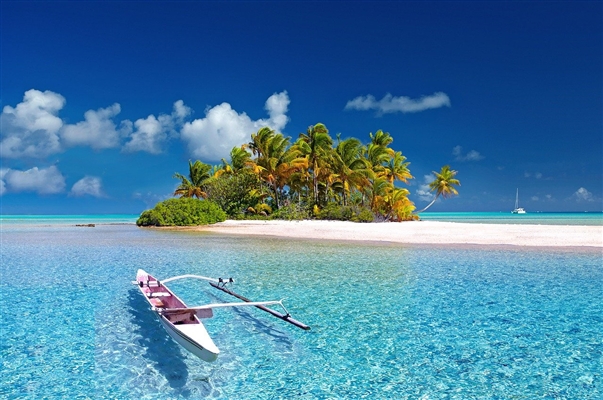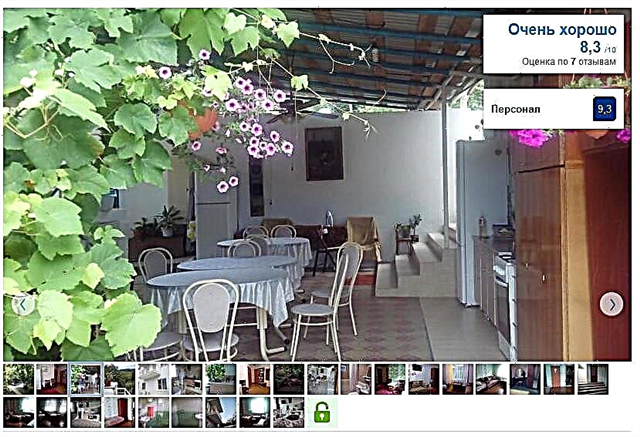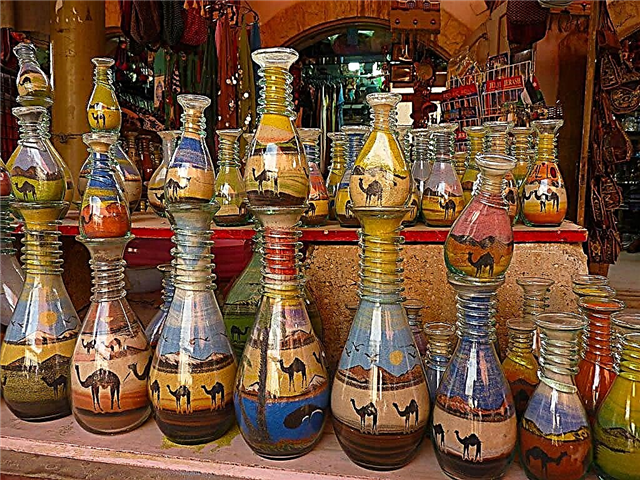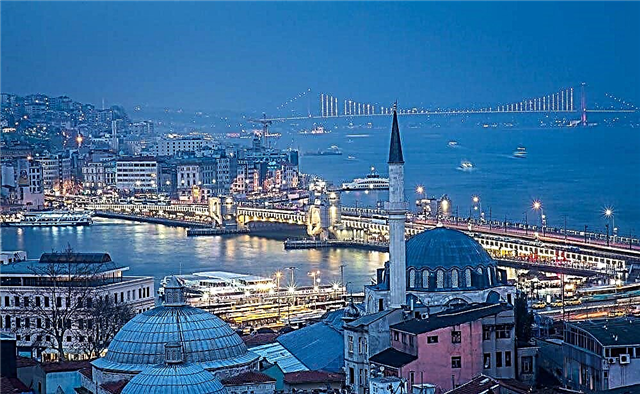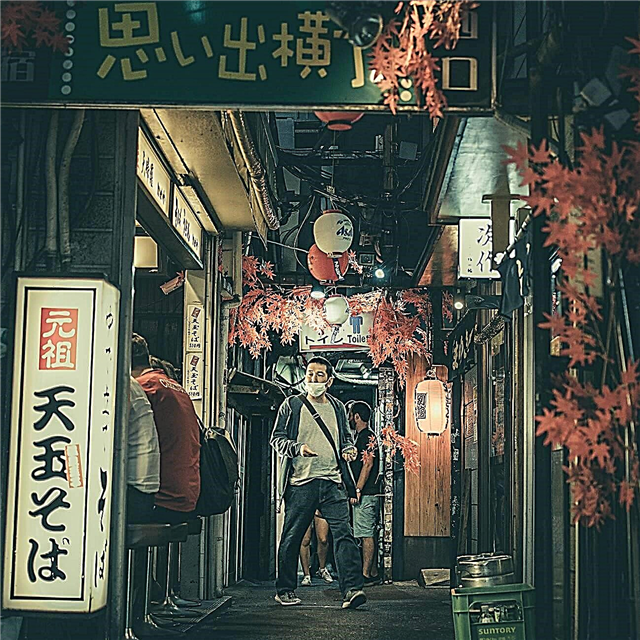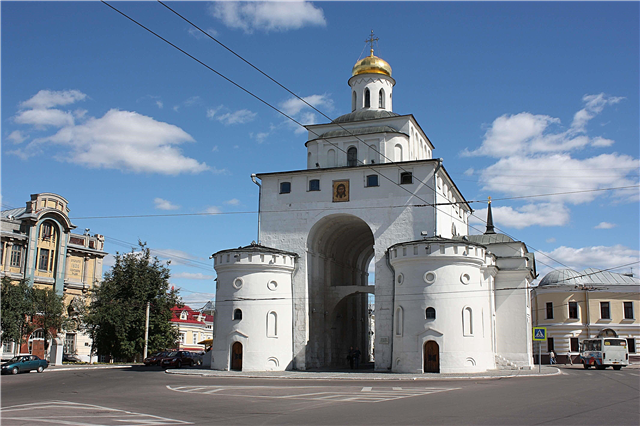The city attracts many tourists not only from Russia, but also from all over the world. A large number of architectural sights of Vladimir are included in the UNESCO cultural heritage list - the Assumption Cathedral, the Dmitrievsky Cathedral, the Church of the Intercession on the Nerl. Ancient temples and monasteries form the basis of any excursion program. To get acquainted with the classical architecture of the 19th century, it is worth taking a walk along Bolshaya Moskovskaya Street.
You can appreciate all the beauty of the ancient city from above. For this, observation platforms have been equipped in Vladimir. You can also see the city from a 50-meter height on the Sky 33 attraction. Popular among tourists are visits to museums that are unusual on the subject - the Spoon Museum, the Old Pharmacy Museum, and the Lights of Vladimir. One of the most unexpected museums is located in the Vladimirsky Central prison - it became popular after the release of the song by Mikhail Krug.
The most interesting and beautiful places
List, photo with names and descriptions of popular sights of Vladimir. These are the main objects of tourist interest. The article will help you find out the places and make routes for exploring the city in 1-3 days.
Assumption Cathedral
An ancient outstanding monument of the architecture of Russia of the pre-Mongol period. It was founded in 1158 and for several centuries the princes of Moscow and Vladimir were married there. The Assumption Cathedral is included in the list of sites protected by UNESCO. Several fragments of frescoes have been preserved on the walls since the 12th century. Also preserved are several sections of the 15th century murals, which were made by Andrei Rublev.

Read about all the top places in the region: the main attractions of the Vladimir region.
Dmitrievsky Cathedral
Founded by the Grand Duke Vsevolod the Big Nest in 1191. Protected by UNESCO. The temple is notable for white stone carvings - figures and ornaments. In total, about 600 reliefs have been applied, most of which have been preserved in their original form. On the southern façade, there is a composition depicting Alexander the Great ascending to heaven. Fragments of the 12th century frescoes depicting the Last Judgment have been preserved.

Golden Gate
UNESCO heritage site. From the seven gates of a single extended shaft, only the ceremonial Golden Gate has survived. Built in 1164 as a triumphal arch and defensive structure. They led to the richest princely part of the city. Now the premises of the Golden Gate house a military exposition of the Vladimir-Suzdal Museum and a diorama depicting the assault of Vladimir in 1238 by Khan Batu.

Park named after A.S.Pushkin
Located in the old part of the city next to historical and cultural monuments. It stretches from Cathedral Square to the observation deck. The park has monuments to Andrei Rublev, Prince Vladimir, St. Fyodor, as well as a monument in honor of the 850th anniversary of the city. The park is well landscaped - it has walkways among green spaces, beautiful flower beds, and a fountain.

Monument to Prince Vladimir and Saint Fyodor
The monument was erected in 2007 and its opening is timed to the memorable date of the transfer of the capital of the principality to Vladimir and to the commemoration day of St. Vladimir. Prince Vladimir is depicted on horseback and in armor, St. Fyodor is standing nearby. They look at the city stretching in front of them. The monument is located in the park to them. Pushkin on the observation deck. It offers a beautiful view of the old part of the city, the Klyazma River and the Assumption Cathedral.

Park "Lipki"
The old city park. The first trees were planted here back in 1847, and since 1901 they have continued to design the park. A fountain was installed in the center of the park, a green zone was equipped and decorated. Linden trees were the first planted trees, hence the name of the park. Many townspeople took part in the arrangement of the park and planting seedlings. The historical park in the city center is popular with visitors and residents of the city.

Patriarchal Garden
Officially, the garden is about 400 years old. Located on a high slope with a height difference of 31 meters. The unique relief made it possible to create an incredibly beautiful landscape zone, which became Vladimir's decoration. The area of the garden is about 4 hectares, it is planted with a rich collection of plants from different parts of the world - more than 100 species of fruit trees and 110 varieties of floral and ornamental plants. The park is decorated with a fountain and an artificial lake.

Dormition Knyaginin monastery
Founded in 1200 on the initiative of Princess Maria Shvarnovna - the wife of Prince Vsevolod the Big Nest. In it, she was buried after death. The monastery became the burial vault of the princes and princesses of the Vladimir clan. The main building of the monastery is the Dormition Cathedral of the 16th century. It was built on the foundations of an older temple. The frescoes of 1648, which were worked on by Moscow artists, have survived to this day.

Theotokos-Rozhdestvensky monastery
It was first mentioned in 1191. It contains the ancient Laurentian Chronicle. Before the creation of the Trinity-Sergius Lavra, it was the main monastic center of the Vladimir and Suzdal principalities. The restoration of the monastery began at the beginning of the 21st century. The Church of the Nativity of Christ in 1866 was restored, anew erected on the site of the destroyed Cathedral in honor of the Nativity of the Most Holy Theotokos, a temple with a bell tower was built. Nevsky.

Ferris wheel "Sky 33"
The attraction appeared in Vladimir in 2015 and immediately became one of the most popular attractions in the city. The 50 meter high wheel is one of the 10 tallest rides of this kind in the country. The wheel is equipped with dynamic lighting, which illuminates the sky with bright colors in the dark. For tourists, riding a Ferris wheel is a great opportunity to enjoy the ancient architecture of Vladimir from above.

Interesting places to walk
The city has pedestrian streets with sights and green parks with alleys where you can walk.
Georgievskaya street
The pedestrian area on Georgievskaya Street is a great place to walk. There are many cultural sites here. A special highlight of the street is the multitude of unusual art objects from folklore and the historical past of the city. On the street there are monuments to a mischievous boy, a pharmacist, an artist, a firefighter, the Scientist Cat, a cherry, a dachshund, and a wallet. With all the monuments, original and memorable photographs are obtained.

Observation decks on Georgievskaya
It is also worth visiting Georgievskaya Street in order to enjoy the beautiful views from the observation platforms. The first one is located near the Cherry Monument - it offers an excellent view of hundreds of plants in the Patriarch's Garden, on the Zaklyazmensky distance. Two more observation platforms are located near the Borodins' smithy. From here you can see old churches and monasteries, including the Assumption Cathedral, you can see the Pushkin Park.

Central Park of Culture and Rest
The 15.5 hectare park is located in the city center. Most of it is occupied by a green area, where walkways and benches are laid out. From entertainment, guests are offered attractions - a room of fear, a chain carousel, a Ferris wheel and others. There is a sports and dance floor. A ski rental is available in winter. On the territory of the park there is a health-improving complex with two swimming pools and a sauna.
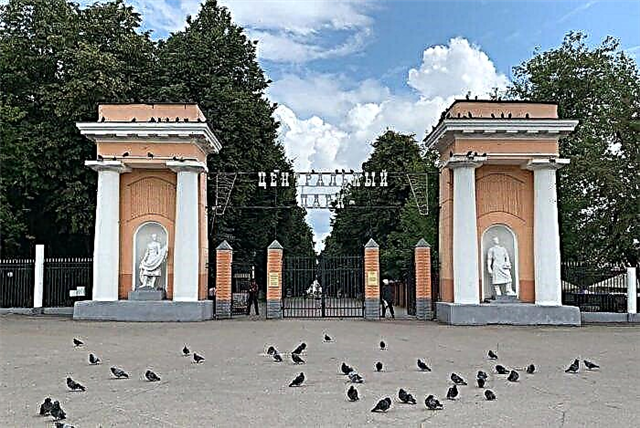
Bolshaya Moskovskaya street
The old city street was founded in the 17th century - it was the center of the city's commercial and festive life. In the 19th century, the street was lined with cobblestones and lanterns were installed. The appearance of the central street of the city is largely determined by the buildings that have survived on it from the 18th and 19th centuries. More than 20 buildings on the street are architectural monuments. Of particular interest are the buildings of the Gostiny Dvor, the City Duma, the Nobility Assembly, and Public Places.

The best museums of Vladimir
The most interesting museums in the city, which you should definitely visit.
Museum complex "Chambers"
Located in the historic Public Building of the 18th century. The stone building was designed by the architect Karl Blank. Since the 1990s, museum expositions have been located in its premises. The exhibitions of the art gallery display canvases by Aivazovsky, Makovsky, Vasnetsov, Kramskoy, as well as masterpieces of Old Russian icon painting. There is an archaeological hall that tells about the Paleolithic and Stone Age.

Historical Museum
Located in a beautiful brick building in the Old Russian style, built at the beginning of the 20th century. The upper floor has beautiful wall paintings. The museum's expositions are dedicated to the history of the Vladimir region from ancient times to the 20th century. Particular attention is paid to the period of the city's development in the XII-XIII centuries. An ancient treasure of 1238, found in 1993, is a unique collection. It consisted of silver coins and church relics.

Museum "Crystal. Lacquer miniature. Embroidery"
Occupies the premises of the former Trinity Church. The building is an architectural monument as an example of a rare pseudo-Russian architectural style. The museum, whose expositions tell about the history of folk crafts in Vladimir, was opened in 1974. The museum displays unique glass and crystal products - cups, decanters, vases. A striking exhibit is the installation "Memories of Venice" by Muratov.

Center for the Promotion of Fine Arts
Located in the Governor's House, built in the 18th century. Every year it hosts exhibitions of Vladimir art representatives. They have different subjects - painting, sculpture, graphics, works of arts and crafts and temple art. The museum's own permanent collection contains many works by Russian masters, including unusual ones - made of glass, ceramics, metal, and embroidery.

"Spoon Museum"
The unique collection of the museum consists of 20,000 exhibits. There are about 3,000 spoons and forks in the display cases - coronation spoons of the Windsor dynasty, spoons made by the suppliers of the Romanov dynasty, geographical, apostolic, there is a spoon of love from Wales. Guests of the museum will be told about the history of the appearance of the spoon, introduced to the techniques of making cutlery, and told about the signs associated with spoons.

House-Museum of brothers Stoletov
Opened in 1976 in the outbuilding of a classic 19th century house. The building has been restored to its historical layout according to the preserved drawings. The interiors of small and large living rooms have been recreated, the atmosphere of a merchant's house, merchant life and everyday life has been conveyed. The expositions contain documents and photographs telling about the Stoletov family and the activities of the brothers, one of whom was a renowned physicist, the other a military leader.

Forge-Museum of the Borodins
Museum visitors are introduced to the world of blacksmithing. The Borodins are hereditary blacksmiths and use ancient technologies in their work. The founders of the museum work in the workshop themselves, as well as conduct excursions and master classes. Forged products are placed not only indoors, but also outdoors. Their subjects are varied - candlesticks, locks, lattices, panels with small details in the form of animals and birds, there is a 22-kilogram chain mail.
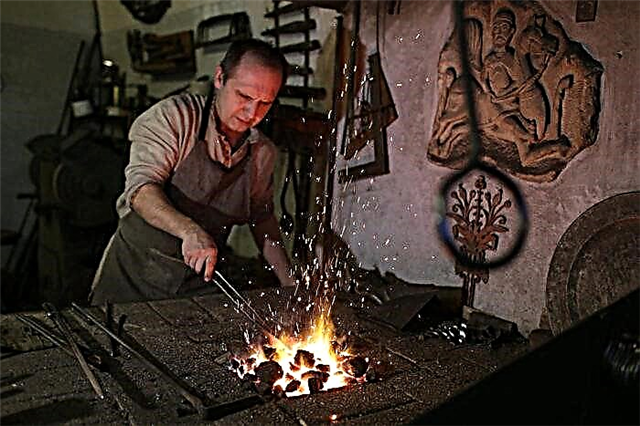
Museum "Old Pharmacy"
The pharmacy was founded in 1805 by the governor Dolgorukov and worked until 2010. This is the city's first state-owned pharmacy. The building has a semicircular entrance with two columns and awnings. It harmoniously fits into the overall architectural appearance of the street. Since 2017, it houses a museum dedicated to pharmacy. It contains about 100 exhibits of the 18th-19th centuries. They are placed among the interiors that convey the atmosphere of the 19th century.

Museum "Lights of Vladimir"
A museum with an original theme - it is dedicated to the history of street lighting in Vladimir. In it you can learn interesting knowledge from physics. You can get acquainted with electricity by studying lighting devices. Exhibits can be touched with hands, experiments are carried out in the hall of light and color. On excursions, they show how a torch, a kerosene and an electric lantern burns, talk about the achievements of science in the field of lighting.

Theaters of Vladimir
The city has two major theatrical stages - the Drama Theater and the Philharmonic.
Vladimir Regional Drama Theater
The theater building stands out among the old buildings of Vladimir for its strict features of the constructivist style. The Vladimir Drama Theater was founded in the 19th century and its performances from the first seasons received recognition from the public - not only the local. The theater often and successfully tours the cities of the country. The theater's repertoire includes more than 60 performances - from classical to modern. There are performances for children's audiences.

Vladimir Regional Philharmonic
Founded in 1944. In the 1960s, the Philharmonic received a new building, which made it possible to create a large number of professional groups and hold major festivals and competitions. Every year, the philharmonic collectives hold about 700 concerts on their home stage, as well as in other cities and countries, which are attended by more than 100,000 spectators. Many artists of the Philharmonic Society have the title of "People's Artists of Russia" and are world famous.

Temples and churches of Vladimir
The most famous places of worship, historical churches, Orthodox and Catholic sights of the city.
Church of St. George the Victorious
The current white-stone church was erected in 1776 on the site of a burnt church, which was mentioned in chronicles as early as 1129. The church has an elegant look. It was built in a baroque style, which is rare for temples. The walls of the temple have a pleasant light yellow color, on which white pilasters and platbands stand out. The hipped bell tower is connected to the refectory church. The painting of the walls was done in the 19th century in the classical style.

Church of the Holy Rosary
An architectural monument of the federal level. The Catholic temple was founded in 1894. After the church was closed in Soviet times, the church bell tower was used as a repeater for a long time. Restoration work began in the 1990s. The architectural ensemble of the temple consists of a priest's house and a church. They are made of red brick in the neo-Gothic style. The windows are lancet, the window above the crucifix is round.

Nikitskaya church
Built in 1760 at the expense of the merchant Semyon Lazarev. Later, with the money of the merchant Filosofov, the church was rebuilt, adding a school building and clergy. In 1899, thanks to the donations of the merchant Goncharov, gilded kliros and an iconostasis appeared. Nikitin Church is a well-preserved example of provincial baroque. In the interior, the iconostasis with the carved Royal Gates stands out.

Spasskaya and Nikolskaya churches
A single picturesque architectural ensemble of two churches is located on Spassky Hill. The first Church of the Savior was built in the 12th century near the princely court of Andrei Bogolyubsky. After a fire in the 18th century, the church was rebuilt on the old foundation. A small Nikolskaya Church was built near Spasskaya at the beginning of the 17th century. It was distinguished by a rich decor - a border of kokoshniks, lush carved platbands.

Nicholas Kremlin Church
The stone church with a four-tiered bell tower was built in the 18th century. It has a baroque shape and a unique pillarless design. Since 1962, a planetarium has been located within its walls. The building's unusual dome design allows for circular images of the Moon, Mars, and Earth's north pole. The diorama of the planetarium depicts a ship taking off into space. There are models of artificial earth satellites.

Architectural landmarks of Vladimir
Monuments of architecture and urban planning, famous buildings and structures that are worth seeing.
Vladimir Central
Russian prison, founded by order of Catherine II in 1783 for especially dangerous criminals. In 1906, the name "central prison" was shortened to the short "central".In the 20th century, it began to contain political prisoners - spies, terrorists, Socialist-Revolutionaries, nationalists. In 1996, a museum was founded at the prison. In Russia, the name "Vladimirsky Central" became widely known after the song of the same name by M. Krug.

Complex "Trading Rows"
The building of the Trading Rows was built at the end of the 18th century. The construction took four years. The project of the retail space was carried out by the architect Nikolai von Berk, following the likeness of a similar building in St. Petersburg. The complex is a gallery of 51 shops, enclosed in a rectangle. You could get inside through the main arch, which is popularly called the Babi Gate. Now it is a large shopping complex with an area of 30,000 m².

City Duma building
Built in 1906 and is an architectural monument. The building looks like a tower - red brick masonry, rich decoration, a high corner turret with a weather vane. In the interior decoration, some of the sculptures, shades and imitation of marble on the walls have been preserved. The wing attached to the building in the 1930s stands out. It is distinguished by its classic style of construction and simple design.

Real school building
An architectural monument in the city center, built at the end of the 19th century. Out of 17 projects submitted to the Society of Architects, a sketch by Grigoriev and Lygin was chosen. The three-storey building of the school was built in the Art Nouveau style. It is decorated with sculptures by scientists Mendeleev and Stoletov, as well as semi-columns. Currently, the building hosts classes for students of the Vladimir State University.

State Bank building
The beautiful and original building was designed by the architect Knopf. It was built in just two years; construction was completed in 1896. The building is distinguished by a facade made with geometric rigor. A contrasting color scheme adds elegance to the building. In 1913, a monument to Alexander II was erected in front of the bank, which in 1918 was replaced with a monument to Freedom, and in 1925 a monument to Lenin was erected in its place.

Water tower
The tower, built at the beginning of the 20th century, is one of the symbols of the city. It was built in the neo-Russian style of red brick and bears little resemblance to an engineering structure. Its appearance is more reminiscent of a fortress building. Since 1975, the Old Vladimir Museum has been housed within the walls of the tower. It tells about the life of the city at the turn of the 19th and 20th centuries. Newspaper clippings are used as explanatory notes for the exhibits.

The building of the former Noble Assembly
An architectural monument of the early 19th century. The impressive building was built in the strict classicism style. The symmetrical central façade is adorned with a portico with six pairs of columns. Inside the building there are luxuriously decorated halls. Stucco molding and wall paintings created a magnificent atmosphere for balls and receptions. Now the building is occupied by the Center for Culture and Art. Exhibitions, film lectures, meetings and concerts are held.

Monuments and monuments of Vladimir
The most famous monuments decorating the streets of the city.
Monument in honor of the 850th anniversary of the city of Vladimir
Located in the center of Cathedral Square. Opened in 1960. It is a triangular 22-meter obelisk. At its base there are statues that symbolize the three stages of Vladimir's life - an ancient Russian hero, an architect and a worker. Popularly, these statues are nicknamed "The Three Lazy". The plots of the bas-reliefs on the obelisk show the city life of the past and the future. The pedestal of the monument is faced with dark marble.
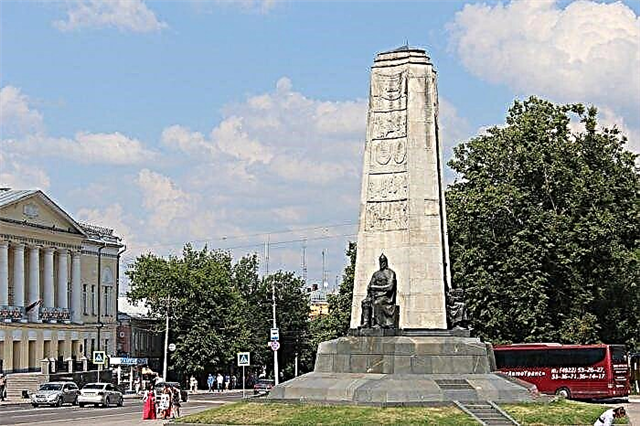
Monument to Alexander Nevsky
The monument to the famous commander was opened in 2003. It was installed near the Rozhdestvensky Monastery, where the grave of Nevsky was previously located. The author of the monument is sculptor Igor Chernoglazov. All work on the installation of the monument was paid for by patrons. On the site of the monument, a bust of Nevsky was previously located, however, according to the decision of the city mayor's office, the full-length monument of the hero is more consistent with the importance of the commander's personality.

Monument to Andrei Rublev
The bronze sculpture of the icon painter is located at the entrance to the park. Pushkin. Rublev worked a lot in Vladimir. The largest number of surviving frescoes by Rublyov is located in the Assumption Cathedral. By installing the monument, residents of the city express their gratitude for his ingenious work. The sculptor depicted the artist in monastic attire and enthusiastic about his work. He holds a brush in one hand, an icon board in the other.

Monument to the announcer Levitan
The monument to the native of Vladimir, the famous announcer, whose voice the whole country knew, was installed in 2015. The authors of the project, Igor Chernoglazov and Yevgeny Usenko, faced a difficult task - to make a monument to a person whom people do not know by sight. The monument is a sculptural composition - in wartime, grandfather and grandson listen with hope to the voice of Levitan, which comes from the loudspeaker.

Attractions in the vicinity of Vladimir
Interesting places near the city, where you can go on weekends by car.
Church of the Intercession on the Nerl
The austere white-stone church was built in the 12th century. It is located 10 km from Vladimir in the village of Bogolyubovo. It is called one of the most beautiful churches in Russia for the harmony and laconicism of the Romanesque style. The facade is decorated with 19 bas-reliefs and high narrow arches. UNESCO included it in the list of protected cultural heritage sites. Until now, the church has been preserved almost unchanged.

Bogolyubsky monastery
Another interesting building in the village of Bogolyubovo. The nunnery was founded presumably in the 13th century. It is believed that it was erected to atone for a terrible sin - the murder of Prince Andrei Bogolyubsky. The monastery stands on the territory of the prince's castle - the only civil building of pre-Mongol times that has survived at least partially. The churches of the monastery were built or restored in the 18th-19th centuries.

Barbecue Park "Cape Verde"
The recreation center, located on the bank of the Sodyshka reservoir. Guests are offered outdoor recreation among picturesque views and fresh air in comfortable conditions a few minutes drive from Vladimir. There are grill houses, houses with a Russian bath, chalets with a heated pool and the interiors of a medieval castle. Guests can barbecue, fish, ride on catamarans, swim and sunbathe, or plunge into the ice-hole in winter.

Read about the best vacation spots in the region: 35 best recreation centers in the Vladimir region.
Khrapovitsky's estate
The palace and castle complex, built at the turn of the 19th and 20th centuries. It is a federal cultural heritage site. The estate is located 40 km from Vladimir in the village of Muromtsevo. The manor was built in a rare style that imitates medieval European castles. Landscaping solutions for an area of 40 hectares combined the principles of landscape and regular planning. Most of the surviving buildings are in need of restoration.



